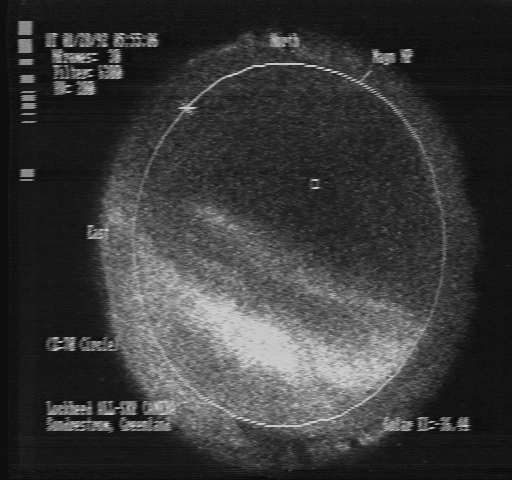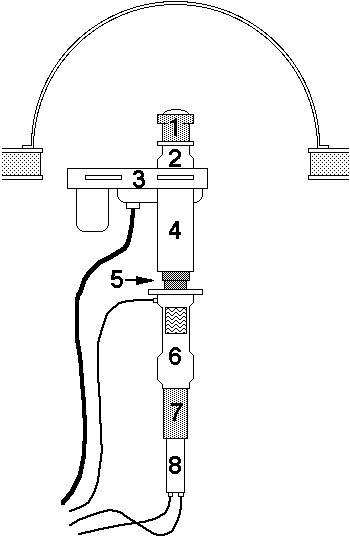
Above is a sample image from the all-sky camera at Sondrestrom, Greenland. The selected narrow band filter is at the 630.0 nm wavelength of neutral oxygen emission coming from the ~200 km altitude region. This auroral arc was viewed on January 12, 1995 at 2215 UT.
The circular image of the sky has zenith at its center and extends to the horizon in all directions. The zenith angle is approximately linear, and azimuth proceeds counterclockwise linearly from zero (geographic north) at the top of the image -- i.e. east is to the left and west is to the right, oriented as if looking upward.
The 110-foot radar dish, to the south, appears at the bottom of the image. Local hills to the east and west of the valley are silhouetted against the 630.0 nm aurora in the sky.
The camera is a Pulnix TM-745 with 15-mm (diagonal) 512 x 480 pixel CCD, situated behind an image intensifier, filter wheel, and fish-eye lens.
The video output signal is digitized with an Imaging Technologies video frame grabber board (CFG) in a 486 personal computer, image header information is added, and the digital image files are saved to hard disk and optionally made available to the public. All acquired video frames are also annotated with date, time, and exposure parameters and recorded on VHS tape for Lockheed archive.
Image angular resolution: approx. 0.5 degrees (~0.01 radian). Zenith spatial resolution at 100 km altitude: approx 1 km. Zenith spatial resolution at 200 km altitude: approx 2 km.
Filter wavelengths (current installation, since Nov 1993):
All filters are approx 3.0 nm bandpass. Filter diameter is 75 mm and thickness up to 7 mm can be accommodated in the 5-position computer controlled filter wheel.
The exposure integration time is variable. The intensifier gain setting is variable. These variables are specified by the user. The primary trade-off is that higher intensifier gains allow shorter exposure times at the expense of noisier (more grainy) image data.
Exposure times for moderate auroral activity range from 1 second at high gain to 30 seconds or a full minute at low intensifier gain. In nominal operations two or three bracketing exposures of differing duration are collected at each filter setting.
In the "patrol" mode the acquisition program cycles through four filters (427.8, 630.0, 486.2, 489.5) in 85 seconds. A few seconds are required for each disk-write, placing an upper limit on the time resolution of digitized imagery (there is space on the 1-Gb hard disk for approx 5000 images). The disk-writes can be limited or disabled entirely, allowing more rapid acquisition to the video tape.
At nominal intensifier gain, sensitivity is on the order of 10 counts per kilo Rayleigh per second, somewhat wavelength (filter) dependent. (Eight-bit pixel values are bounded in the digitization to a range of 10 to 240 counts.) Thus a one-second exposure will saturate at about 24 kR, while a 24-second exposure will saturate near 1 kR.
The optical assembly is mounted vertically under a 3-foot clear plastic dome at the northwest corner of the upper floor in the main site building.

Components, from top down, are:
The dome is heated by a thermo-statically controlled electric space heater.
Control electronics/data acquisition equipment:
All exposures are recorded on the time-lapse VCR as they are collected. The time-lapse VCR is set to record continuously at 1/12 rate (2-hr cassette records for 24 hrs) from a video frame memory, into which exposures are initially grabbed by the all-sky software.
Last update: 10 June 1999
by Harald U. Frey, hfrey at ssl.berkeley.edu